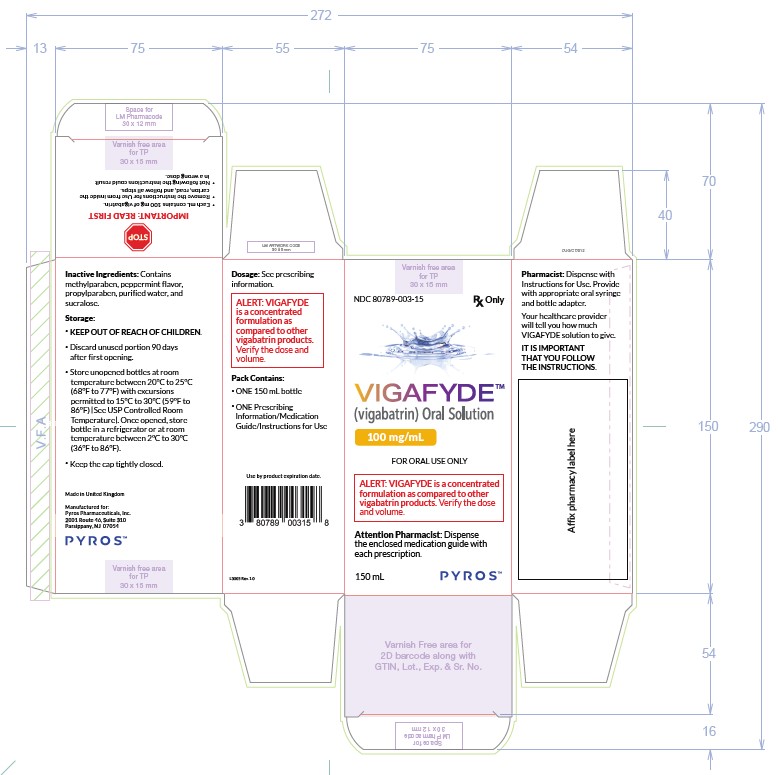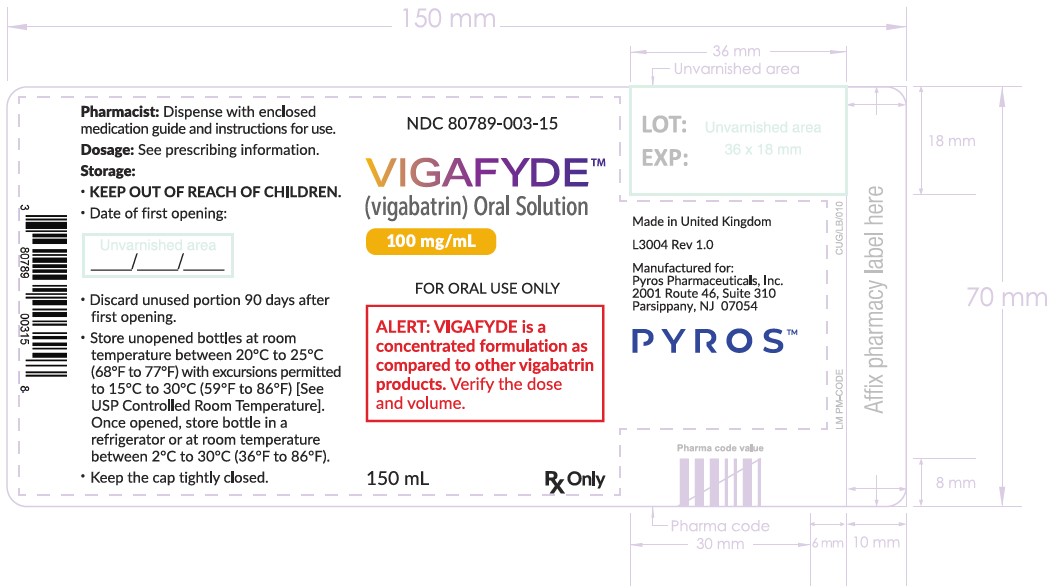Vigafyde: Package Insert / Prescribing Info
Package insert / product label
Generic name: vigabatrin
Dosage form: oral solution
Drug class: Gamma-aminobutyric acid analogs
Medically reviewed by Drugs.com. Last updated on Sep 23, 2025.
On This Page
- Indications and Usage
- Dosage and Administration
- Dosage Forms and Strengths
- Contraindications
- Warnings and Precautions
- Adverse Reactions/Side Effects
- Drug Interactions
- Use In Specific Populations
- Overdosage
- Description
- Clinical Pharmacology
- Nonclinical Toxicology
- Clinical Studies
- How Supplied/Storage and Handling
- Storage and Handling
- Patient Counseling Information
- Medication Guide
Highlights of Prescribing Information
VIGAFYDE® (vigabatrin) oral solution
Initial U.S. Approval: 2009
WARNING: PERMANENT VISION LOSS
See full prescribing information for complete boxed warning.
- VIGAFYDE can cause permanent bilateral concentric visual field constriction, including tunnel vision that can result in disability. In some cases, VIGAFYDE may also decrease visual acuity. (5.1)
- Risk increases with increasing dose and cumulative exposure, but there is no dose or exposure to VIGAFYDE known to be free of risk of vision loss. (5.1)
- Risk of new and worsening vision loss continues as long as VIGAFYDE is used, and possibly after discontinuing VIGAFYDE. (5.1)
- Baseline and periodic vision assessment is recommended for patients on VIGAFYDE. However, this assessment cannot always prevent vision damage. (5.1)
- VIGAFYDE is available only through a restricted program called the Vigabatrin REMS. (5.2)
Indications and Usage for Vigafyde
VIGAFYDE is indicated as monotherapy for the treatment of infantile spasms in pediatric patients 1 month to 2 years of age for whom the potential benefits outweigh the potential risk of vision loss. (1)
Vigafyde Dosage and Administration
- VIGAFYDE is a concentrated formulation as compared to other vigabatrin products. Verify the strength and the dose of the product prior to prescribing, dispensing, and administering. (2.1)
- Administer VIGAFYDE orally or via gastrostomy (G) tube. Doses administered via gastrojejunal (GJ) tubes must be administered through the G-port. (2.1)
- Initiate at a daily dosage of 50 mg/kg (25 mg/kg twice daily); increase total daily dosage every 3 days, in increments of 25 mg/kg/day to 50 mg/kg/day, up to a maximum daily dosage of 150 mg/kg (75 mg/kg twice daily). (2.2)
Dosage Forms and Strengths
- Oral Solution : 100 mg/mL (3)
Contraindications
None (4)
Warnings and Precautions
Adverse Reactions/Side Effects
The most common adverse reactions (incidence ˃5% and greater than on placebo) in patients with infantile spasms include somnolence, bronchitis, ear infection, and acute otitis media. (6.1)
To report SUSPECTED ADVERSE REACTIONS, contact Upsher-Smith Laboratories, LLC at 1-855-899-9180 or FDA at 1-800-FDA-1088 or www.fda.gov/medwatch.
Drug Interactions
Decreased phenytoin plasma levels: Dosage adjustment may be needed. (7.1)
See 17 for PATIENT COUNSELING INFORMATION and Medication Guide.
Revised: 9/2025
Full Prescribing Information
WARNING: PERMANENT VISION LOSS
- VIGAFYDE can cause permanent bilateral concentric visual field constriction, including tunnel vision that can result in disability. In some cases, VIGAFYDE also can damage the central retina and may decrease visual acuity [see Warnings and Precautions (5.1)].
- The onset of vision loss from VIGAFYDE is unpredictable, and can occur within weeks of starting treatment or sooner, or at any time after starting treatment, even after months or years.
- Symptoms of vision loss from VIGAFYDE are unlikely to be recognized by patients or caregivers before vision loss is severe. Vision loss of milder severity, while often unrecognized by the patient or caregiver, can still adversely affect function.
- The risk of vision loss increases with increasing dose and cumulative exposure, but there is no dose or exposure known to be free of risk of vision loss.
- Vision assessment is recommended at baseline (no later than 4 weeks after starting VIGAFYDE), at least every 3 months during therapy, and about 3 to 6 months after the discontinuation of therapy.
- Once detected, vision loss due to VIGAFYDE is not reversible. It is expected that, even with frequent monitoring, some patients will develop severe vision loss.
- Consider drug discontinuation, balancing benefit and risk, if vision loss is documented.
- Risk of new or worsening vision loss continues as long as VIGAFYDE is used. It is possible that vision loss can worsen despite discontinuation of VIGAFYDE.
- Because of the risk of vision loss, VIGAFYDE should be withdrawn from patients with infantile spasms who fail to show substantial clinical benefit within 2 to 4 weeks of initiation, or sooner if treatment failure becomes obvious. Patient response to and continued need for VIGAFYDE should be periodically reassessed.
- VIGAFYDE should not be used in patients with, or at high risk of, other types of irreversible vision loss unless the benefits of treatment clearly outweigh the risks.
- VIGAFYDE should not be used with other drugs associated with serious adverse ophthalmic effects such as retinopathy or glaucoma unless the benefits clearly outweigh the risks.
- Use the lowest dosage and shortest exposure to VIGAFYDE consistent with clinical objectives [see Dosage and Administration (2.1)].
Because of the risk of permanent vision loss, VIGAFYDE is available only through a restricted program under a Risk Evaluation and Mitigation Strategy (REMS) called the Vigabatrin REMS [see Warnings and Precautions (5.1)]. Further information is available at www.vigabatrinREMS.com or call 1-866-244-8175.
1. Indications and Usage for Vigafyde
VIGAFYDE is indicated as monotherapy for the treatment of infantile spasms in pediatric patients 1 month to 2 years of age for whom the potential benefits outweigh the potential risk of vision loss [see Warnings and Precautions (5.1)].
2. Vigafyde Dosage and Administration
2.1 Important Dosing and Administration Instructions
Dosing
VIGAFYDE is a solution of 100 mg/mL of vigabatrin. VIGAFYDE is a concentrated solution as compared to other vigabatrin products. Verify strength and the dose of the product prior to prescribing, dispensing, and administering [see Dosage and Administration (2.3)]. VIGAFYDE does not require additional reconstitution or dilution prior to administration.
Use the lowest dosage and shortest exposure to VIGAFYDE consistent with clinical objectives [see Warnings and Precautions (5.1)].
The VIGAFYDE dosing regimen depends on weight.
Monitoring of VIGAFYDE plasma concentrations to optimize therapy is not helpful.
Administration
Administer VIGAFYDE orally or via gastrostomy (G) tube. Doses administered via gastrojejunal (GJ) tubes must be administered through the G-port. After G-tube administration, flush with water.
VIGAFYDE can be given with or without food.
A calibrated measuring device is recommended to measure and deliver the prescribed dose accurately. A household teaspoon or tablespoon is not an adequate measuring device.
If a decision is made to discontinue VIGAFYDE, the dose should be gradually reduced [see Dosage and Administration (2.4) and Warnings and Precautions (5.5)].
2.2 Recommended Dosage for Infantile Spasms
The initial daily dosing is 50 mg/kg/day given in two divided doses (25 mg/kg twice daily); subsequent dosing can be titrated by 25 mg/kg/day to 50 mg/kg/day increments every 3 days, up to a maximum of 150 mg/kg/day given in 2 divided doses (75 mg/kg twice daily) [see Use in Specific Populations (8.4)].
Table 1 provides the volume of the 100 mg/mL dosing solution that should be administered as individual doses in infants of various weights.
| Weight
[kg] | Starting Dose
50 mg/kg/day | Maximum Dose
150 mg/kg/day |
| 3 | 75 mg (0.75 mL) twice daily | 225 mg (2.25 mL) twice daily |
| 4 | 100 mg (1 mL) twice daily | 300 mg (3 mL) twice daily |
| 5 | 125 mg (1.25 mL) twice daily | 375 mg (3.75 mL) twice daily |
| 6 | 150 mg (1.5 mL) twice daily | 450 mg (4.5 mL) twice daily |
| 7 | 175 mg (1.75 mL) twice daily | 525 mg (5.25 mL) twice daily |
| 8 | 200 mg (2 mL) twice daily | 600 mg (6 mL) twice daily |
| 9 | 225 mg (2.25 mL) twice daily | 675 mg (6.75 mL) twice daily |
| 10 | 250 mg (2.5 mL) twice daily | 750 mg (7.5 mL) twice daily |
| 11 | 275 mg (2.75 mL) twice daily | 825 mg (8.25 mL) twice daily |
| 12 | 300 mg (3 mL) twice daily | 900 mg (9 mL) twice daily |
| 13 | 325 mg (3.25 mL) twice daily | 975 mg (9.75 mL) twice daily |
| 14 | 350 mg (3.5 mL) twice daily | 1,050 mg (10.5 mL) twice daily |
| 15 | 375 mg (3.75 mL) twice daily | 1,125 mg (11.25 mL) twice daily |
| 16 | 400 mg (4 mL) twice daily | 1,200 mg (12 mL) twice daily |
In patients with infantile spasms, VIGAFYDE should be withdrawn if a substantial clinical benefit is not observed within 2 to 4 weeks. If, in the clinical judgment of the prescriber, evidence of treatment failure becomes obvious earlier than 2 to 4 weeks, treatment should be discontinued at that time [see Warnings and Precautions (5.1)].
2.3 Switching Between Other Vigabatrin Products and VIGAFYDE
If switching between other vigabatrin products and VIGAFYDE, ensure the correct volume for the correct dosage is prescribed, dispensed, and administered. As compared to other vigabatrin products, VIGAFYDE is a concentrated solution that requires a smaller volume than other vigabatrin products to obtain the same dosage (i.e., VIGAFYDE is 100 mg/mL and currently available vigabatrin for oral solution products have a final concentration of 50 mg/mL).
2.4 Discontinuation of VIGAFYDE
Avoid abrupt withdrawal [see Warnings and Precautions (5.5)]. In a controlled clinical study in patients with infantile spasms, vigabatrin was tapered by decreasing the daily dosage at a rate of 25 to 50 mg/kg every 3 to 4 days.
3. Dosage Forms and Strengths
Oral Solution : 100 mg/mL clear, colorless to light yellow solution with a peppermint odor.
5. Warnings and Precautions
5.1 Permanent Vision Loss
VIGAFYDE can cause permanent vision loss. Because of this risk and because, when it is effective, VIGAFYDE provides an observable symptomatic benefit; patient response and continued need for treatment should be periodically assessed.
VIGAFYDE is indicated for treatment in patients 1 month to 2 years of age [see Indications and Usage (1)]. VIGAFYDE is not approved for use in pediatric patients older than 2 years of age or in adults. Based upon adult studies, 30 percent or more of patients can be affected with bilateral concentric visual field constriction ranging in severity from mild to severe. Severe cases may be characterized by tunnel vision to within 10 degrees of visual fixation, which can result in disability. In some cases, VIGAFYDE also can damage the central retina and may decrease visual acuity. Symptoms of vision loss from VIGAFYDE are unlikely to be recognized by patients or caregivers before vision loss is severe. Vision loss of milder severity, while often unrecognized by the patient or caregiver, can still adversely affect function.
Because assessing vision may be difficult in infants and children, the frequency and extent of vision loss is poorly characterized in these patients. For this reason, the understanding of the risk is primarily based on the adult experience. The possibility that vision loss from VIGAFYDE may be more common, more severe, or have more severe functional consequences in infants than in adults cannot be excluded.
The onset of vision loss from VIGAFYDE is unpredictable and can occur within weeks of starting treatment or sooner, or at any time after starting treatment, even after months or years.
The risk of vision loss increases with increasing dose and cumulative exposure, but there is no dose or exposure known to be free of risk of vision loss.
In patients with infantile spasms, VIGAFYDE should be withdrawn if a substantial clinical benefit is not observed within 2 to 4 weeks. If, in the clinical judgment of the prescriber, evidence of treatment failure becomes obvious earlier than 2 to 4 weeks, treatment should be discontinued at that time [see Dosage and Administration (2.2) and Warnings and Precautions (5.5)].
VIGAFYDE should not be used in patients with, or at high risk of, other types of irreversible vision loss unless the benefits of treatment clearly outweigh the risks. The interaction of other types of irreversible vision damage with vision damage from VIGAFYDE has not been well-characterized, but is likely adverse.
VIGAFYDE should not be used with other drugs associated with serious adverse ophthalmic effects such as retinopathy or glaucoma unless the benefits clearly outweigh the risks.
Monitoring of Vision
Monitoring of vision by an ophthalmic professional with expertise in visual field interpretation and the ability to perform dilated indirect ophthalmoscopy of the retina is recommended [see Warnings and Precautions (5.2)]. Because vision testing in infants is difficult, vision loss may not be detected until it is severe. For patients receiving VIGAFYDE, vision assessment is recommended at baseline (no later than 4 weeks after starting VIGAFYDE), at least every 3 months while on therapy, and about 3 to 6 months after the discontinuation of therapy. The diagnostic approach should be individualized for the patient and clinical situation.
In cooperative pediatric patients, perimetry is recommended, preferably by automated threshold visual field testing. Additional testing may also include electrophysiology (e.g., electroretinography [ERG]), retinal imaging (e.g., optical coherence tomography [OCT]), and/or other methods appropriate for the patient. In patients who cannot be tested, treatment may continue according to clinical judgment, with appropriate caregiver counseling. Because of variability, results from ophthalmic monitoring must be interpreted with caution, and repeat assessment is recommended if results are abnormal or uninterpretable. Repeat assessment in the first few weeks of treatment is recommended to establish if, and to what degree, reproducible results can be obtained, and to guide selection of appropriate ongoing monitoring for the patient.
The onset and progression of vision loss from VIGAFYDE is unpredictable, and it may occur or worsen precipitously between assessments. Once detected, vision loss due to VIGAFYDE is not reversible. It is expected that even with frequent monitoring, some VIGAFYDE patients will develop severe vision loss. Consider drug discontinuation, balancing benefit and risk, if vision loss is documented. It is possible that vision loss can worsen despite discontinuation of VIGAFYDE.
5.2 Vigabatrin REMS
VIGAFYDE is available only through a restricted distribution program called the Vigabatrin REMS, because of the risk of permanent vision loss.
Notable requirements of the Vigabatrin REMS include the following:
- Prescribers must be certified by enrolling in the program, agreeing to counsel caregivers on the risk of vision loss and the need for periodic monitoring of vision, and reporting any event suggestive of vision loss to the REMS program.
- Patients must enroll in the program.
- Pharmacies must be certified and must only dispense to patients authorized to receive VIGAFYDE.
Further information is available at www.vigabatrinREMS.com or by calling 1-866-244-8175.
5.3 Magnetic Resonance Imaging Abnormalities in Infants
Abnormal magnetic resonance imaging (MRI) signal changes characterized by increased T2 signal and restricted diffusion in a symmetric pattern involving the thalamus, basal ganglia, brain stem, and cerebellum have been observed in some infants treated with vigabatrin.
In a retrospective epidemiologic study in infants with infantile spasms (N=205), the prevalence of MRI changes was 22% in vigabatrin-treated patients versus 4% in patients treated with other therapies. In this study, in postmarketing experience, and in published literature reports, these changes generally resolved with discontinuation of treatment. In a few patients, the lesion resolved despite continued use. It has been reported that some infants exhibited coincident motor abnormalities, but no causal relationship has been established and the potential for long-term clinical sequelae has not been adequately studied.
Neurotoxicity (brain histopathology and neurobehavioral abnormalities) was observed in rats exposed to vigabatrin during late gestation and the neonatal and juvenile periods of development, and brain histopathological changes were observed in dogs exposed to vigabatrin during the juvenile period of development. The relationship between these findings and the abnormal MRI findings in infants treated with vigabatrin for infantile spasms is unknown [see Warnings and Precautions (5.4) and Use in Specific Populations (8.1)].
5.4 Neurotoxicity
Intramyelinic Edema (IME) has been reported in postmortem examination of infants being treated for infantile spasms with vigabatrin.
Abnormal MRI signal changes characterized by increased T2 signal and restricted diffusion in a symmetric pattern involving the thalamus, basal ganglia, brain stem, and cerebellum have also been observed in some infants treated for IS with vigabatrin [see Warnings and Precautions (5.3)].
Vacuolation, characterized by fluid accumulation and separation of the outer layers of myelin, has been observed in brain white matter tracts in adult and juvenile rats and adult mice, dogs, and possibly monkeys following administration of vigabatrin. This lesion, referred to as intramyelinic edema (IME), was seen in animals at doses within the human therapeutic range. A no-effect dose was not established in rodents or dogs. In the rat and dog, vacuolation was reversible following discontinuation of vigabatrin treatment, but, in the rat, pathologic changes consisting of swollen or degenerating axons, mineralization, and gliosis were seen in brain areas in which vacuolation had been previously observed. Vacuolation in adult animals was correlated with alterations in MRI and changes in visual and somatosensory EP.
Administration of vigabatrin to rats during the neonatal and juvenile periods of development produced vacuolar changes in the brain gray matter (including the thalamus, midbrain, deep cerebellar nuclei, substantia nigra, hippocampus, and forebrain) which are considered distinct from the IME observed in vigabatrin-treated adult animals. Decreased myelination and evidence of oligodendrocyte injury were additional findings in the brains of vigabatrin-treated rats. An increase in apoptosis was seen in some brain regions following vigabatrin exposure during the early postnatal period. Long-term neurobehavioral abnormalities (convulsions, neuromotor impairment, learning deficits) were also observed following vigabatrin treatment of young rats. Administration of vigabatrin to juvenile dogs produced vacuolar changes in the brain gray matter (including the septal nuclei, hippocampus, hypothalamus, thalamus, cerebellum, and globus pallidus). Neurobehavioral effects of vigabatrin were not assessed in the juvenile dog. These effects in young animals occurred at doses lower than those producing neurotoxicity in adult animals and were associated with plasma vigabatrin levels substantially lower than those achieved clinically in infants [see Use in Specific Populations (8.4)].
In a published study, vigabatrin (200, 400 mg/kg/day) induced apoptotic neurodegeneration in the brain of young rats when administered by intraperitoneal injection on postnatal days 5 to 7.
5.5 Withdrawal of Antiepileptic Drugs
As with all antiepileptic drugs, VIGAFYDE should be withdrawn gradually [see Dosage and Administration (2.4)]. However, if withdrawal is needed because of a serious adverse event, rapid discontinuation can be considered. Caregivers should be told not to suddenly discontinue VIGAFYDE therapy.
5.6 Anemia
Across U.S. controlled trials, there were mean decreases in hemoglobin of about 3% and 0% in vigabatrin and placebo-treated patients, respectively, and a mean decrease in hematocrit of about 1% in vigabatrin-treated patients compared to a mean gain of about 1% in patients treated with placebo.
In controlled and open-label epilepsy trials in adults and pediatric patients, 3 vigabatrin patients (0.06%, 3/4,855) discontinued for anemia and 2 vigabatrin patients experienced unexplained declines in hemoglobin to below 8 g/dL and/or hematocrit below 24%.
5.7 Somnolence and Fatigue
VIGAFYDE causes somnolence and fatigue.
Pooled data from three vigabatrin controlled trials in pediatric patients demonstrated that 6% (10/165) of vigabatrin patients experienced somnolence compared to 5% (5/104) of placebo patients. In those same studies, 10% (17/165) of vigabatrin patients experienced fatigue compared to 7% (7/104) of placebo patients. No vigabatrin patients discontinued from clinical trials due to somnolence or fatigue.
VIGAFYDE is indicated for treatment in patients 1 month to 2 years of age [see Indications and Usage (1)]. VIGAFYDE is not approved for use in adults. Pooled data from two vigabatrin controlled trials in adults demonstrated that 24% (54/222) of vigabatrin patients experienced somnolence compared to 10% (14/135) of placebo patients. In those same studies, 28% of vigabatrin patients experienced fatigue compared to 15% (20/135) of placebo patients. Almost 1% of vigabatrin patients discontinued from clinical trials for somnolence and almost 1% discontinued for fatigue.
5.8 Peripheral Neuropathy
VIGAFYDE is indicated for treatment in patients 1 month to 2 years of age [see Indications and Usage (1)]. VIGAFYDE is not approved for use in adults. Vigabatrin causes symptoms of peripheral neuropathy in adults. Pediatric clinical trials were not designed to assess symptoms of peripheral neuropathy, but observed incidence of symptoms based on pooled data from controlled pediatric studies appeared similar for pediatric patients on vigabatrin and placebo. In a pool of North American controlled and uncontrolled epilepsy studies, 4.2% (19/457) of vigabatrin patients developed signs and/or symptoms of peripheral neuropathy. In the subset of North American placebo-controlled epilepsy trials, 1.4% (4/280) of vigabatrin treated patients and no (0/188) placebo patients developed signs and/or symptoms of peripheral neuropathy. Initial manifestations of peripheral neuropathy in these trials included, in some combination, symptoms of numbness or tingling in the toes or feet, signs of reduced distal lower limb vibration or position sensation, or progressive loss of reflexes, starting at the ankles. Clinical studies in the development program were not designed to investigate peripheral neuropathy systematically and did not include nerve conduction studies, quantitative sensory testing, or skin or nerve biopsy. There is insufficient evidence to determine if development of these signs and symptoms was related to duration of vigabatrin treatment, cumulative dose, or if the findings of peripheral neuropathy were completely reversible upon discontinuation of vigabatrin.
5.9 Weight Gain
VIGAFYDE causes weight gain in pediatric patients.
Data pooled from randomized controlled trials in pediatric patients with a different indication found that 47% (77/163) of vigabatrin patients versus 19% (19/102) of placebo patients gained ≥7% of baseline body weight.
In all epilepsy trials, 0.6% (31/4,855) of VIGAFYDE patients discontinued for weight gain. The long-term effects of vigabatrin related weight gain are not known. Weight gain was not related to the occurrence of edema.
5.10 Edema
VIGAFYDE is approved for use in patients 1 month to 2 years of age [see Indications and Usage (1)]. VIGAFYDE is not approved for use in adults. Vigabatrin causes edema in adults. Pediatric clinical trials were not designed to assess edema, but observed incidence of edema-based pooled data from controlled pediatric studies appeared similar for pediatric patients on vigabatrin and placebo.
Pooled data from controlled trials demonstrated increased risk among patients treated with vigabatrin powder for oral solution compared to placebo patients for peripheral edema (vigabatrin powder for oral solution 2%, placebo 1%), and edema (vigabatrin powder for oral solution 1%, placebo 0%). In these studies, one patient treated with vigabatrin powder for oral solution and no placebo patients discontinued for an edema related adverse event. In adults, there was no apparent association between edema and cardiovascular adverse events such as hypertension or congestive heart failure. Edema was not associated with laboratory changes suggestive of deterioration in renal or hepatic function.
5.11 Suicidal Behavior and Ideation with Unapproved Use in Adolescents and Adults
VIGAFYDE is approved for use in patients 1 month to 2 years of age [see Indications and Usage (1)]. VIGAFYDE is not approved for use in adolescents or adults. Antiepileptic drugs (AEDs) increase the risk of suicidal thoughts or behavior in adolescents and adults. Patients treated with any AED for any indication should be monitored for the emergence or worsening of depression, suicidal thoughts or behavior, and/or any unusual changes in mood or behavior.
Pooled analyses of 199 placebo-controlled clinical trials (mono- and adjunctive therapy) of 11 different AEDs showed that adult patients randomized to one of the AEDs had approximately twice the risk (adjusted relative risk 1.8, 95% confidence interval [CI]: 1.2, 2.7) of suicidal thinking or behavior compared to adult patients randomized to placebo. In these trials, which had a median treatment duration of 12 weeks, the estimated incidence rate of suicidal behavior or ideation among 27,863 AED-treated adult patients was 0.43%, compared to 0.24% among 16,029 placebo-treated adult patients, representing an increase of approximately one case of suicidal thinking or behavior for every 530 adult patients treated. There were four suicides in drug-treated adult patients in the trials and none in placebo-treated adult patients, but the number was too small to allow any conclusion about AED effect on suicide.
The increased risk of suicidal thoughts or behavior in adults with AEDs was observed as early as one week after starting AED treatment and persisted for the duration of treatment assessed. Because most trials included in the analysis did not extend beyond 24 weeks, the risk of suicidal thoughts or behavior beyond 24 weeks could not be assessed. The risk of suicidal thoughts or behavior was generally consistent among drugs in the data analyzed. The finding of increased risk with AEDs of varying mechanisms of action and across a range of indications suggests that the risk applies to all AEDs used for any indication.
6. Adverse Reactions/Side Effects
The following serious and otherwise important adverse reactions are described elsewhere in labeling:
- Permanent Vision Loss [see BOXED WARNING and Warnings and Precautions (5.1)]
- Magnetic Resonance Imaging (MRI) Abnormalities in Infants [see Warnings and Precautions (5.3)]
- Neurotoxicity [see Warnings and Precautions (5.4)]
- Withdrawal of Antiepileptic Drugs (AEDs) [see Warnings and Precautions (5.5)]
- Anemia [see Warnings and Precautions (5.6)]
- Somnolence and Fatigue [see Warnings and Precautions (5.7)]
- Peripheral Neuropathy [see Warnings and Precautions (5.8)]
- Weight Gain [see Warnings and Precautions (5.9)]
- Edema [see Warnings and Precautions (5.10)]
- Suicidal Behavior and Ideation with Unapproved use in Adolescents and Adults [see Warnings and Precautions (5.11)]
6.1 Clinical Trials Experience
Because clinical trials are conducted under widely varying conditions, adverse reaction rates observed in the clinical trials of a drug cannot be directly compared to rates in the clinical trials of another drug and may not reflect the rates observed in practice.
Infantile Spasms
In a randomized, placebo-controlled study in patients with infantile spasms (IS) with a 5 day double-blind treatment phase (n=40), the adverse reactions that occurred in ≥5% of patients receiving vigabatrin and that occurred more frequently than in placebo patients were somnolence (vigabatrin 45%, placebo 30%), bronchitis (vigabatrin 30%, placebo 15%), ear infection (vigabatrin 10%, placebo 5%), and acute otitis media (vigabatrin 10%, placebo 0%).
In patients with IS, the adverse reactions most commonly associated with vigabatrin treatment discontinuation in ≥1% of patients were infections, status epilepticus, developmental coordination disorder, dystonia, hypotonia, hypertonia, weight gain, and insomnia.
In a dose response study of low-dose (18 to 36 mg/kg/day, which is below the recommended starting dose for IS of 50 mg/kg/day) versus high-dose (100 to 148 mg/kg/day) vigabatrin, no clear correlation between dose and incidence of adverse reactions was observed. The adverse reactions (≥5% in either dose group) are summarized in Table 2.
|
Body System Adverse Reaction | Vigabatrin Low Dose [N=114] % | Vigabatrin High Dose [N=108] % |
| Eye Disorders (other than field or acuity changes) | ||
| Strabismus | 5 | 5 |
| Conjunctivitis | 5 | 2 |
| Gastrointestinal Disorders | ||
| Vomiting | 14 | 20 |
| Constipation | 14 | 12 |
| Diarrhea | 13 | 12 |
| General Disorders | ||
| Fever | 29 | 19 |
| Infections | ||
| Upper respiratory tract infection | 51 | 46 |
| Otitis media | 44 | 30 |
| Viral infection | 20 | 19 |
| Pneumonia | 13 | 11 |
| Candidiasis | 8 | 3 |
| Ear infection | 7 | 14 |
| Gastroenteritis viral | 6 | 5 |
| Sinusitis | 5 | 9 |
| Urinary tract infection | 5 | 6 |
| Influenza | 5 | 3 |
| Croup infectious | 5 | 1 |
| Metabolism & Nutrition Disorders | ||
| Decreased appetite | 9 | 7 |
| Nervous System Disorders | ||
| Sedation | 19 | 17 |
| Somnolence | 17 | 19 |
| Status epilepticus | 6 | 4 |
| Lethargy | 5 | 7 |
| Convulsion | 4 | 7 |
| Hypotonia | 4 | 6 |
| Psychiatric Disorders | ||
| Irritability | 16 | 23 |
| Insomnia | 10 | 12 |
| Respiratory Disorders | ||
| Nasal congestion | 13 | 4 |
| Cough | 3 | 8 |
| Skin and Subcutaneous Tissue Disorders | ||
| Rash | 8 | 11 |
6.2 Postmarketing Experience
The following adverse reactions have been identified during postapproval use of vigabatrin. Because these reactions are reported voluntarily from a population of uncertain size, it is not always possible to reliably estimate their frequency or establish a causal relationship to drug exposure.
Ear Disorders: Deafness
Endocrine Disorders: Delayed puberty
Gastrointestinal Disorders: Gastrointestinal hemorrhage, esophagitis
General Disorders: Developmental delay, facial edema, malignant hyperthermia, multi-organ failure
Hepatobiliary Disorders: Cholestasis
Nervous System Disorders: Dystonia, encephalopathy, hypertonia, hypotonia, muscle spasticity, myoclonus, optic neuritis, dyskinesia
Psychiatric Disorders: Acute psychosis, apathy, delirium, hypomania, neonatal agitation, psychotic disorder
Respiratory Disorders: Laryngeal edema, pulmonary embolism, respiratory failure, stridor
Skin and Subcutaneous Tissue Disorders: Angioedema, maculo-papular rash, pruritus, Stevens-Johnson syndrome (SJS), toxic epidermal necrolysis (TEN), alopecia
Related/similar drugs
7. Drug Interactions
7.1 Antiepileptic Drugs
Phenytoin
Although phenytoin dose adjustments are not routinely required, dose adjustment of phenytoin should be considered if clinically indicated, since VIGAFYDE may cause a moderate reduction in total phenytoin plasma levels [see Clinical Pharmacology (12.3)].
Clonazepam
VIGAFYDE may moderately increase the Cmax of clonazepam resulting in an increase of clonazepam-associated adverse reactions [see Clinical Pharmacology (12.3)].
7.2 Drug-Laboratory Test Interactions
VIGAFYDE decreases alanine transaminase (ALT) and aspartate transaminase (AST) plasma activity in up to 90% of patients. In some patients, these enzymes become undetectable. The suppression of ALT and AST activity by vigabatrin may preclude the use of these markers, especially ALT, to detect early hepatic injury.
VIGAFYDE may increase the amount of amino acids in the urine, possibly leading to a false positive test for certain rare genetic metabolic diseases (e.g., alpha aminoadipic aciduria).
8. Use In Specific Populations
8.1 Pregnancy
VIGAFYDE is indicated for treatment in patients 1 month to 2 years of age [see Indications and Usage (1)]. VIGAFYDE is not approved for use in adolescents and adults.
Pregnancy Exposure Registry
There is a pregnancy exposure registry that monitors pregnancy outcomes in women exposed to AEDs, including VIGAFYDE, during pregnancy. Encourage women who are taking VIGAFYDE during pregnancy to enroll in the North American Antiepileptic Drug (NAAED) Pregnancy Registry. This can be done by calling the toll-free number 1-888-233-2334 or visiting the website, http://www.aedpregnancyregistry.org/. This must be done by the patient herself.
Risk Summary
There are no adequate data on the developmental risk associated with the use of VIGAFYDE in pregnant women. Limited available data from case reports and cohort studies pertaining to vigabatrin use in pregnant women have not established a drug-associated risk of major birth defects, miscarriage, or adverse maternal or fetal outcomes. However, based on animal data, VIGAFYDE use in pregnant women may result in fetal harm.
When administered to pregnant animals, vigabatrin produced developmental toxicity, including an increase in fetal malformations and offspring neurobehavioral and neurohistopathological effects, at clinically relevant doses. In addition, developmental neurotoxicity was observed in rats treated with vigabatrin during a period of postnatal development corresponding to the third trimester of human pregnancy (see Data).
In the U.S. general population, the estimated background risk of major birth defects and miscarriage in clinically recognized pregnancies is 2 to 4% and 15 to 20%, respectively. The background risk of major birth defects and miscarriage for the indicated population is unknown.
Data
Animal Data
Administration of vigabatrin (oral doses of 50 to 200 mg/kg/day) to pregnant rabbits throughout the period of organogenesis was associated with an increased incidence of malformations (cleft palate) and embryofetal death; these findings were observed in two separate studies. The no-effect dose for adverse effects on embryofetal development in rabbits (100 mg/kg/day) is approximately 1/2 the maximum recommended human dose (MRHD) of 3 g/day on a body surface area (mg/m2) basis. In rats, oral administration of vigabatrin (50, 100, or 150 mg/kg/day) throughout organogenesis resulted in decreased fetal body weights and increased incidences of fetal anatomic variations. The no-effect dose for adverse effects on embryo-fetal development in rats (50 mg/kg/day) is approximately 1/5 the MRHD on a mg/m2 basis. Oral administration of vigabatrin (50, 100, 150 mg/kg/day) to rats from the latter part of pregnancy through weaning produced long-term neurohistopathological (hippocampal vacuolation) and neurobehavioral (convulsions) abnormalities in the offspring. A no-effect dose for developmental neurotoxicity in rats was not established; the low-effect dose (50 mg/kg/day) is approximately 1/5 the MRHD on a mg/m2 basis.
In a published study, vigabatrin (300 or 450 mg/kg) was administered by intraperitoneal injection to a mutant mouse strain on a single day during organogenesis (day 7, 8, 9, 10, 11, or 12). An increase in fetal malformations (including cleft palate) was observed at both doses.
Oral administration of vigabatrin (5, 15, or 50 mg/kg/day) to young rats during the neonatal and juvenile periods of development (postnatal days 4 to 65) produced neurobehavioral (convulsions, neuromotor impairment, learning deficits) and neurohistopathological (brain vacuolation, decreased myelination, and retinal dysplasia) abnormalities in treated animals. The early postnatal period in rats is generally thought to correspond to late pregnancy in humans in terms of brain development. The no-effect dose for developmental neurotoxicity in juvenile rats (5 mg/kg/day) was associated with plasma vigabatrin exposures (AUC) less than 1/30 of those measured in pediatric patients receiving an oral dose of 50 mg/kg.
8.2 Lactation
VIGAFYDE is indicated for treatment in patients 1 month to 2 years of age [see Indications and Usage (1)]. VIGAFYDE is not approved for use in adolescents and adults.
Risk Summary
Vigabatrin is excreted in human milk. The effects of vigabatrin on the breastfed infant and on milk production are unknown. Because of the potential for serious adverse reactions from vigabatrin in nursing infants, breastfeeding is not recommended. If exposing a breastfed infant to VIGAFYDE, observe for any potential adverse effects [see Warnings and Precautions (5.1, 5.3, 5.4, 5.8)].
8.4 Pediatric Use
The safety and effectiveness of vigabatrin as monotherapy for pediatric patients with infantile spasms (1 month to 2 years of age) have been established [see Dosage and Administration (2.2) and Clinical Studies (14.1)].
Safety and effectiveness as a monotherapy for the treatment of infantile spasms in pediatric patients below the age of 1 month have not been established.
Duration of therapy for infantile spasms was evaluated in a post hoc analysis of a Canadian Pediatric Epilepsy Network (CPEN) study of developmental outcomes in infantile spasms patients. This analysis suggests that a total duration of 6 months of vigabatrin therapy is adequate for the treatment of infantile spasms. However, prescribers must use their clinical judgment as to the most appropriate duration of use [see Clinical Studies (14.1)].
Abnormal MRI signal changes and Intramyelinic Edema (IME) in infants and young children being treated with vigabatrin have been observed [see Warnings and Precautions (5.3, 5.4)].
Juvenile Animal Toxicity Data
Oral administration of vigabatrin (5, 15, or 50 mg/kg/day) to young rats during the neonatal and juvenile periods of development (postnatal days 4 to 65) produced neurobehavioral (convulsions, neuromotor impairment, learning deficits) and neurohistopathological (brain gray matter vacuolation, decreased myelination, and retinal dysplasia) abnormalities. The no-effect dose for developmental neurotoxicity in juvenile rats (the lowest dose tested) was associated with plasma vigabatrin exposures (AUC) substantially less than those measured in pediatric patients at recommended doses. In dogs, oral administration of vigabatrin (30 or 100 mg/kg/day) during selected periods of juvenile development (postnatal days 22 to 112) produced neurohistopathological abnormalities (brain gray matter vacuolation). Neurobehavioral effects of vigabatrin were not assessed in the juvenile dog. A no-effect dose for neurohistopathology was not established in juvenile dogs; the lowest effect dose (30 mg/kg/day) was associated with plasma vigabatrin exposures lower than those measured in pediatric patients at recommended doses [see Warnings and Precautions (5.4)].
8.5 Geriatric Use
VIGAFYDE is indicated for treatment in patients 1 month to 2 years of age [see Indications and Usage (1)]. VIGAFYDE is not approved for use in adults.
Clinical studies of vigabatrin did not include sufficient numbers of patients aged 65 and over to determine whether they responded differently from younger patients.
Vigabatrin is known to be substantially excreted by the kidney, and the risk of toxic reactions to this drug may be greater in patients with impaired renal function. Because elderly patients are more likely to have decreased renal function, care should be taken in dose selection, and it may be useful to monitor renal function.
Oral administration of a single dose of 1.5 g of vigabatrin to elderly (≥65 years) patients with reduced creatinine clearance (<50 mL/min) was associated with moderate to severe sedation and confusion in 4 of 5 patients, lasting up to 5 days. The renal clearance of vigabatrin was 36% lower in healthy elderly subjects (≥65 years) than in young healthy males. If used in elderly patients, adjustment of dose or frequency of administration should be considered.
Other reported clinical experience has not identified differences in responses between the elderly and younger patients.
10. Overdosage
10.1 Signs, Symptoms, and Laboratory Findings of Overdosage
Confirmed and/or suspected vigabatrin overdoses have been reported during clinical trials and in post marketing surveillance. No vigabatrin overdoses resulted in death. When reported, the vigabatrin dose ingested ranged from 3 g to 90 g, but most were between 7.5 g and 30 g. Nearly half the cases involved multiple drug ingestions including carbamazepine, barbiturates, benzodiazepines, lamotrigine, valproic acid, acetaminophen, and/or chlorpheniramine.
Coma, unconsciousness, and/or drowsiness were described in the majority of cases of vigabatrin overdose. Other less commonly reported symptoms included vertigo, psychosis, apnea or respiratory depression, bradycardia, agitation, irritability, confusion, headache, hypotension, abnormal behavior, increased seizure activity, status epilepticus, and speech disorder. These symptoms resolved with supportive care.
10.2 Management of Overdosage
There is no specific antidote for VIGAFYDE overdose. Standard measures to remove unabsorbed drug should be used, including elimination by emesis or gastric lavage. Supportive measures should be employed, including monitoring of vital signs and observation of the clinical status of the patient.
In an in vitro study, activated charcoal did not significantly adsorb vigabatrin.
The effectiveness of hemodialysis in the treatment of VIGAFYDE overdose is unknown. In isolated case reports in renal failure patients receiving therapeutic doses of vigabatrin, hemodialysis reduced vigabatrin plasma concentrations by 40% to 60%.
11. Vigafyde Description
VIGAFYDE (vigabatrin) oral solution is an antiepileptic drug.
The chemical name of vigabatrin is (±) 4-amino-5-hexenoic acid, a racemic mixture of R and S isomers. The molecular formula is C6H11NO2 and the molecular weight is 129.16. It has the following structural formula:
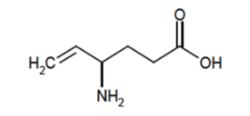
Vigabatrin is a white to off-white powder which is freely soluble in water, slightly soluble in methyl alcohol, very slightly soluble in ethyl alcohol and chloroform, and insoluble in toluene and hexane. The pH of a 1% aqueous solution is about 6.9. The n-octanol/water partition coefficient of vigabatrin is about 0.011 (log P=-1.96) at physiologic pH. Vigabatrin melts with decomposition in a 3-degree range within the temperature interval of 171ºC to 176ºC. The dissociation constants (pKa) of vigabatrin are 4 and 9.7 at room temperature (25ºC).
Each mL of VIGAFYDE contains 100 mg of vigabatrin. The inactive ingredients are methylparaben; peppermint flavor; propylparaben; purified water; and sucralose.
12. Vigafyde - Clinical Pharmacology
12.1 Mechanism of Action
The precise mechanism of vigabatrin’s anti-seizure effect is unknown, but it is believed to be the result of its action as an irreversible inhibitor of γ-aminobutyric acid transaminase (GABA-T), the enzyme responsible for the metabolism of the inhibitory neurotransmitter GABA. This action results in increased levels of GABA in the central nervous system.
No direct correlation between plasma concentration and efficacy has been established. The duration of drug effect is presumed to be dependent on the rate of enzyme re-synthesis rather than on the rate of elimination of the drug from the systemic circulation.
12.2 Pharmacodynamics
Effects on Electrocardiogram
There is no indication of a QT/QTc prolonging effect of vigabatrin in single doses up to 6.0 g. In a randomized, placebo-controlled, crossover study, 58 healthy subjects were administered a single oral dose of vigabatrin (3 g and 6 g) and placebo. Peak concentrations for 6.0 g vigabatrin were approximately 2-fold higher than the peak concentrations following the 3.0 g single oral dose.
12.3 Pharmacokinetics
VIGAFYDE is indicated for treatment in patients 1 month to 2 years of age [see Indications and Usage (1)]. VIGAFYDE is not approved for use in adults.
Vigabatrin displayed linear pharmacokinetics after administration of single doses ranging from 0.5 g to 4 g, and after administration of repeated doses of 0.5 g and 2.0 g twice daily. The following PK information (Tmax, half-life, and clearance) of vigabatrin was obtained from stand-alone PK studies and population PK analyses.
Absorption
Following oral administration, vigabatrin is essentially completely absorbed. The time to maximum concentration (Tmax) is approximately 2.5 hours for infants (5 months to 2 years of age). There was little accumulation with multiple dosing in adult and pediatric patients. A food effect study involving administration of vigabatrin to healthy volunteers under fasting and fed conditions indicated that the Cmax was decreased by 33%, Tmax was increased to 2 hours, and AUC was unchanged under fed conditions.
Distribution
Vigabatrin does not bind to plasma proteins. Vigabatrin is widely distributed throughout the body; mean steady-state volume of distribution is 1.1 L/kg (CV = 20%).
Metabolism and Elimination
Vigabatrin is not significantly metabolized; it is eliminated primarily through renal excretion. The terminal half-life of vigabatrin is about 5.7 hours for infants (5 months to 2 years of age). Following administration of [14]C-vigabatrin to healthy male volunteers, about 95% of total radioactivity was recovered in the urine over 72 hours with the parent drug representing about 80% of this. Vigabatrin induces CYP2C9 but does not induce other hepatic cytochrome P450 enzyme systems.
Specific Populations
Pediatric
The clearance of vigabatrin is 2.4 L/hr for infants (5 months to 2 years of age).
Gender
No gender differences were observed for the pharmacokinetic parameters of vigabatrin in patients.
Race
No specific study was conducted to investigate the effects of race on vigabatrin pharmacokinetics. A cross study comparison between 23 Caucasian and 7 Japanese patients who received 1, 2, and 4 g of vigabatrin indicated that the AUC, Cmax, and half-life were similar for the two populations. However, the mean renal clearance of Caucasians (5.2 L/hr) was about 25% higher than the Japanese (4.0 L/hr). Inter-subject variability in renal clearance was 20% in Caucasians and was 30% in Japanese.
Renal Impairment
Mean AUC increased by 30% and the terminal half-life increased by 55% (8.1 hr vs 12.5 hr) in adult patients with mild renal impairment (CLcr from >50 to 80 mL/min) in comparison to normal subjects.
Mean AUC increased by two-fold and the terminal half-life increased by two-fold in adult patients with moderate renal impairment (CLcr from >30 to 50 mL/min) in comparison to normal subjects.
Mean AUC increased by 4.5-fold and the terminal half-life increased by 3.5-fold in adult patients with severe renal impairment (CLcr from >10 to 30 mL/min) in comparison to normal subjects.
The effect of dialysis on VIGAFYDE clearance has not been adequately studied.
Infants with Renal Impairment
The effect of renal impairment on the pharmacokinetics of VIGAFYDE in infants is unknown.
Hepatic Impairment
Vigabatrin is not significantly metabolized. The pharmacokinetics of vigabatrin in patients with impaired liver function has not been studied.
Drug Interactions
Phenytoin
A 16% to 20% average reduction in total phenytoin plasma levels was reported in adult controlled clinical studies. In vitro drug metabolism studies indicate that decreased phenytoin concentrations upon addition of vigabatrin therapy are likely to be the result of induction of cytochrome P450 2C enzymes in some patients. Although phenytoin dose adjustments are not routinely required, dose adjustment of phenytoin should be considered if clinically indicated [see Drug Interactions (7.1)].
Clonazepam
In a study of 12 healthy adult volunteers, clonazepam (0.5 mg) co-administration had no effect on vigabatrin (1.5 g twice daily) concentrations. Vigabatrin increases the mean Cmax of clonazepam by 30% and decreases the mean Tmax by 45% [see Drug Interactions (7.1)].
Other AEDs
When co-administered with vigabatrin, phenobarbital concentration (from phenobarbital or primidone) was reduced by an average of 8% to 16%, and sodium valproate plasma concentrations were reduced by an average of 8%. These reductions did not appear to be clinically relevant. Based on population pharmacokinetics, carbamazepine, clorazepate, primidone, and sodium valproate appear to have no effect on plasma concentrations of vigabatrin [see Drug Interactions (7.1)].
Alcohol
Co-administration of ethanol (0.6 g/kg) with vigabatrin (1.5 g twice daily) indicated that neither drug influences the pharmacokinetics of the other.
13. Nonclinical Toxicology
13.1 Carcinogenesis, Mutagenesis, Impairment of Fertility
Carcinogenesis
Vigabatrin showed no carcinogenic potential in mouse or rat when given in the diet at doses up to 150 mg/kg/day for 18 months (mouse) or at doses up to 150 mg/kg/day for 2 years (rat). These doses are less than the maximum recommended human dose (MRHD) for infantile spasms (150 mg/kg/day).
Mutagenesis
Vigabatrin was negative in in vitro (Ames, CHO/HGPRT mammalian cell forward gene mutation, chromosomal aberration in rat lymphocytes) and in in vivo (mouse bone marrow micronucleus) assays.
Impairment of Fertility
No adverse effects on male or female fertility were observed in rats at oral doses up to 150 mg/kg/day.
14. Clinical Studies
The efficacy of VIGAFYDE is based upon a comparison of the compositional differences between vigabatrin for oral solution and VIGAFYDE oral solution.
The effectiveness of vigabatrin as monotherapy was established for infantile spasms in two multicenter controlled studies. Both studies were similar in terms of disease characteristics and prior treatments of patients and all enrolled infants had a confirmed diagnosis of infantile spasms.
Study 1
Study 1 (N=221) was a multicenter, randomized, low-dose high-dose, parallel-group, partially-blind (caregivers knew the actual dose but not whether their child was classified as low or high dose; EEG reader was blinded but investigators were not blinded) study to evaluate the safety and efficacy of vigabatrin in patients ˂2 years of age with new-onset infantile spasms. Patients with both symptomatic and cryptogenic etiologies were studied. The study was comprised of two phases. The first phase was a 14 to 21 day partially-blind phase in which patients were randomized to receive either low-dose (18 to 36 mg/kg/day) or high-dose (100 to 148 mg/kg/day) vigabatrin. Study drug was titrated over 7 days, followed by a constant dose for 7 days. If the patient became spasm-free on or before day 14, another 7 days of constant dose was administered. The primary efficacy endpoint of this study was the proportion of patients who were spasm-free for 7 consecutive days beginning within the first 14 days of vigabatrin therapy. Patients considered spasm-free were defined as those patients who remained free of spasms (evaluated according to caregiver response to direct questioning regarding spasm frequency) and who had no indication of spasms or hypsarrhythmia during 8 hours of closed-circuit television EEG recording (including at least one sleep-wake-sleep cycle) performed within 3 days of the seventh day of spasm freedom and interpreted by a blinded EEG reader. Seventeen patients in the high-dose group achieved spasm freedom compared with 8 patients in the low-dose group. This difference was statistically significant (p=0.0375). Primary efficacy results are shown in Table 3.
| Vigabatrin Treatment Group | ||
| 18 to 36 mg/kg/day [N=114] n (%) | 100 to 148 mg/kg/day [N=107] n (%) |
|
| Patients who Achieved Spasm Freedom | 8 (7.0) | 17 (15.9) |
p=0.0375
Note: Primary criteria were evaluated based on caregiver assessment plus CCTV EEG confirmation within 3 days of the seventh day of spasm freedom.
Study 2
Study 2 (N=40) was a multicenter, randomized, double-blind, placebo-controlled, parallel-group study consisting of a pre-treatment (baseline) period of 2 to 3 days, followed by a 5-day double-blind treatment phase during which patients were treated with vigabatrin (initial dose of 50 mg/kg/day with titration allowed to 150 mg/kg/day) or placebo. The primary efficacy endpoint in this study was the average percent change in daily spasm frequency, assessed during a pre-defined and consistent 2-hour window of evaluation, comparing baseline to the final 2 days of the 5-day double-blind treatment phase. No statistically significant differences were observed in the average frequency of spasms using the 2-hour evaluation window. However, a post-hoc alternative efficacy analysis, using a 24-hour clinical evaluation window found a statistically significant difference in the overall percentage of reductions in spasms between the vigabatrin group (68.9%) and the placebo group (17.0%) (p=0.030).
Duration of therapy for infantile spasms was evaluated in a post hoc analysis of a Canadian Pediatric Epilepsy Network (CPEN) study of developmental outcomes in infantile spasms patients. The 38/68 infants in the study who had responded to vigabatrin therapy (complete cessation of spasms and hypsarrhythmia) continued vigabatrin therapy for a total duration of 6 months therapy. The 38 infants who responded were then followed for an additional 18 months after discontinuation of vigabatrin to determine their clinical outcome. A post hoc analysis indicated no observed recurrence of infantile spasms in any of these 38 infants.
16. How is Vigafyde supplied
16.1 How Supplied
VIGAFYDE (vigabatrin) oral solution contains 100 mg/mL vigabatrin. It is a clear, colorless to light yellow, peppermint-flavored solution supplied in a white opaque high-density polyethylene (HDPE) 150 mL bottle in a carton (NDC 80789-003-15).
16.2 Storage and Handling
Store unopened bottles at room temperature between 20°C to 25°C (68°F to 77°F) with excursions permitted to 15°C to 30°C (59°F to 86°F) [See USP Controlled Room Temperature].
After opening, store bottle in a refrigerator or at room temperature between 2°C to 30°C (36°F to 86°F).
Discard the unused portion 90 days after first opening.
17. Patient Counseling Information
Advise caregivers to read the FDA-approved patient labeling (Medication Guide and Instructions for Use).
If a patient is switching from vigabatrin powder for oral solution, inform the caregiver that VIGAFYDE is more concentrated (100 mg/mL) compared to reconstituted solutions of vigabatrin powder for oral solution (50 mg/mL), and the volume of solution that should be given to their infant will be lower than previously prescribed.
Advise patients to stop using other products that contain vigabatrin.
Administration Instructions for VIGAFYDE Oral Solution
Physicians should confirm that caregiver(s) understand how to measure and administer the correct dose of VIGAFYDE oral solution to their infants. Advise caregivers to measure VIGAFYDE with the syringe provided by the pharmacy. A household teaspoon is not an accurate measuring device.
Instruct caregivers that VIGAFYDE should not be diluted prior to dosing.
Advise the caregiver that VIGAFYDE may be given orally or via gastrostomy (G) tube. Doses administered via gastrojejunal (GJ) tubes must be administered through the G-port. If VIGAFYDE will be administered via G-tube, provide instructions to the caregiver(s) as to how to flush the tube after administration.
Advise the caregiver to discard any remaining VIGAFYDE 90 days after first opening.
Permanent Vision Loss
Inform caregivers of the risk of permanent vision loss, particularly loss of peripheral vision, from VIGAFYDE, and the need for monitoring vision [see Warnings and Precautions (5.1)].
Monitoring of vision, including assessment of visual fields and visual acuity, is recommended at baseline (no later than 4 weeks after starting VIGAFYDE), at least every 3 months while on therapy, and about 3 to 6 months after discontinuation of therapy. In patients for whom vision testing is not possible, treatment may continue without recommended testing according to clinical judgment with appropriate caregiver counseling. Caregivers should be informed that if baseline or subsequent vision is not normal, VIGAFYDE should only be used if the benefits of VIGAFYDE treatment clearly outweigh the risks of additional vision loss.
Advise caregivers that vision testing may be insensitive and may not detect vision loss before it is severe. Also advise caregivers that if vision loss is documented, such loss is irreversible. Ensure that both of these points are understood by caregivers.
Caregivers should be informed that if changes in vision are suspected, they should notify their physician immediately.
VIGABATRIN REMS
VIGAFYDE is available only through a restricted program called the Vigabatrin REMS [see Warnings and Precautions (5.2)].
Inform caregivers of the following:
- Patients/caregivers must be enrolled in the program.
- VIGAFYDE is only available through pharmacies that are enrolled in the Vigabatrin REMS.
MRI Abnormalities in Infants
Inform caregiver(s) of the possibility that infants may develop an abnormal MRI signal of unknown clinical significance [see Warnings and Precautions (5.3)].
Withdrawal of VIGAFYDE Therapy
Instruct patients and caregivers not to suddenly discontinue VIGAFYDE therapy without consulting with their healthcare provider. As with all AEDs, withdrawal should normally be gradual [see Warnings and Precautions (5.5)].
Made in the United Kingdom
Distributed by
UPSHER-SMITH LABORATORIES, LLC
Maple Grove, MN 55369
VIGAFYDE is a registered trademark of Pyros Pharmaceuticals, Inc.
PLFT0376-3-370
Medication Guide
|
MEDICATION GUIDE
oral solution |
| What is the most important information I should know about VIGAFYDE?
VIGAFYDE can cause serious side effects, including:
VIGAFYDE can damage the vision of anyone who takes it. Some people can have severe loss particularly to their ability to see to the side when they look straight ahead (peripheral vision). With severe vision loss, your baby may only be able to see things straight in front of them (sometimes called “tunnel vision”). Your baby may also have blurry vision. If this happens, it will not get better.

Brain pictures taken by MRI show changes in some babies after they are given VIGAFYDE. It is not known if these changes are harmful. |
What is VIGAFYDE?
|
|
What should I tell my baby's healthcare provider before starting VIGAFYDE? If you are a parent or caregiver whose baby has IS, before giving VIGAFYDE to your baby, tell your baby's healthcare provider about all of your baby’s medical conditions, including if your baby has or ever had:
|
How should my baby take VIGAFYDE?
|
| What are the possible side effects of VIGAFYDE?
VIGAFYDE can cause serious side effects, including:
VIGAFYDE may make certain types of seizures worse. You should tell your baby’s healthcare provider right away if your baby’s seizures get worse. Tell your baby’s healthcare provider if you see any changes in your baby’s behavior. The most common side effects of VIGAFYDE in babies include:
Tell your healthcare provider if your baby has any side effect that bothers them or does not go away. These are not all the possible side effects of VIGAFYDE.
|
How should I store VIGAFYDE?
|
| General information about the safe and effective use of VIGAFYDE.
Medicines are sometimes prescribed for purposes other than those listed in a Medication Guide. You can ask your pharmacist or healthcare provider for information about VIGAFYDE that is written for health professionals. Do not use VIGAFYDE for a condition for which it was not prescribed. Do not give VIGAFYDE to other people, even if they have the same symptoms. It may harm them. |
|
What are the ingredients in VIGAFYDE?
Made in the United Kingdom Distributed by VIGAFYDE is a registered trademark of Pyros Pharmaceuticals, Inc. For more information, go to www.VIGAFYDE.com or call 1-888-650-3789. |
This Medication Guide has been approved by the U.S. Food and Drug Administration
PLFT0376-3-370
Revised: 9/2025
INSTRUCTIONS FOR USE
VIGAFYDE®(VIG-uh-fide)
(vigabatrin) oral solution
Read this Instructions for Use before your baby starts taking VIGAFYDE and each time you get a refill. There may be new information. This information does not take the place of talking with your baby’s healthcare provider about your baby’s medical condition or treatment. Talk to your baby’s healthcare provider if you have any questions about the right dose of medicine to give your baby or how to measure it.

Powder Formulation Users
VIGAFYDE contains more vigabatrin, 100 mg per milliliter (mL) compared to other types (formulations) of vigabatrin prepared from powder, at 50 mg per mL.
If your baby is switching from vigabatrin prepared from powder to VIGAFYDE oral solution, your baby’s healthcare provider may have prescribed a smaller volume (mL) of medicine than before.
Important Note:
- VIGAFYDE is a concentrated solution compared to other vigabatrin types. Each mL of VIGAFYDE contains 100 mg of vigabatrin.
Each VIGAFYDE oral solution carton contains (see Figure A):
- 1 bottle of VIGAFYDE oral solution
- 1 Medication Guide/Instructions for Use leaflet (not pictured)
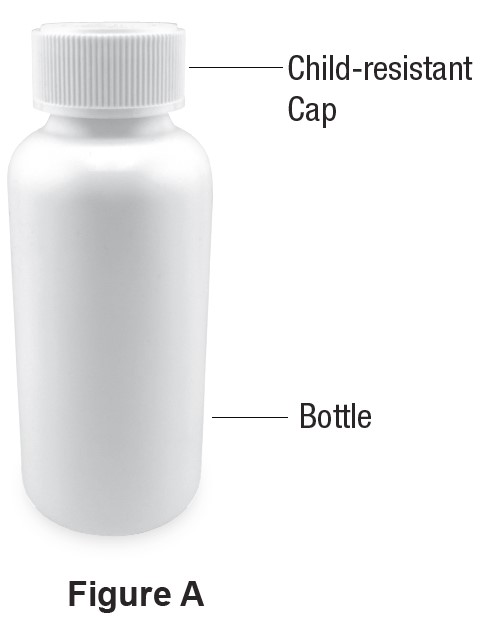
The pharmacy will provide (see Figure B) an:
- Oral Syringe
- Bottle Adapter
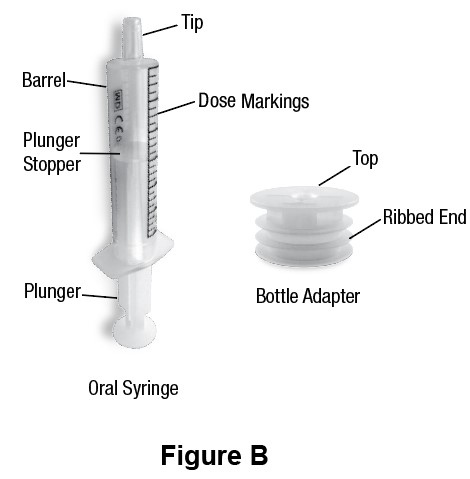
- Your baby's healthcare provider will tell you how many milliliters (mL) of VIGAFYDE you will need for each dose.
- VIGAFYDE may be given by mouth or given through a gastrostomy (G) tube. If VIGAFYDE is given through a gastrojejunal (GJ) tube, the G-port must be used. Give the medicine as directed by your baby’s healthcare provider and flush the tube after administration with the amount of water recommended by your healthcare provider.
- If giving VIGAFYDE by mouth, use the oral syringe provided by the pharmacy to measure and give the prescribed dose. Do not use a household teaspoon or tablespoon.
- Stop using other products that contain vigabatrin. Check with your healthcare provider.
- Check the label on the bottle and make sure the expiration date (EXP) has not passed. If the expiration date has passed, do not use VIGAFYDE. Contact your pharmacy or healthcare provider to get a new bottle of VIGAFYDE.
How to prepare the bottle for first time use of VIGAFYDE oral solution:
Step 1: If needed, separate the bottle adapter from the oral syringe (see Figure C).
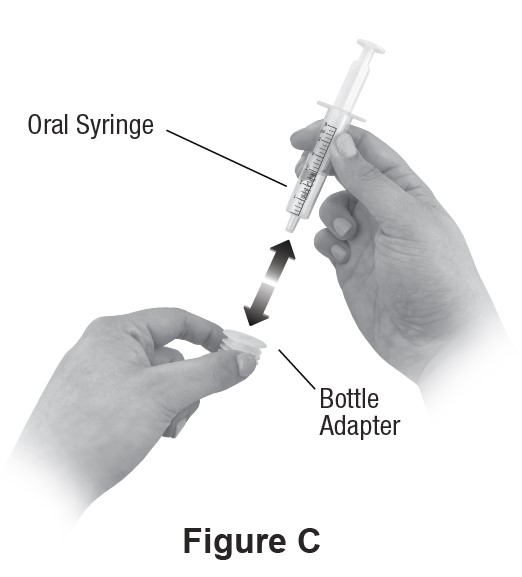
Step 2: Remove the child-resistant-cap by pressing down on the cap and turning it counterclockwise (to the left) (see Figure D). Do not throw away the child-resistant cap.
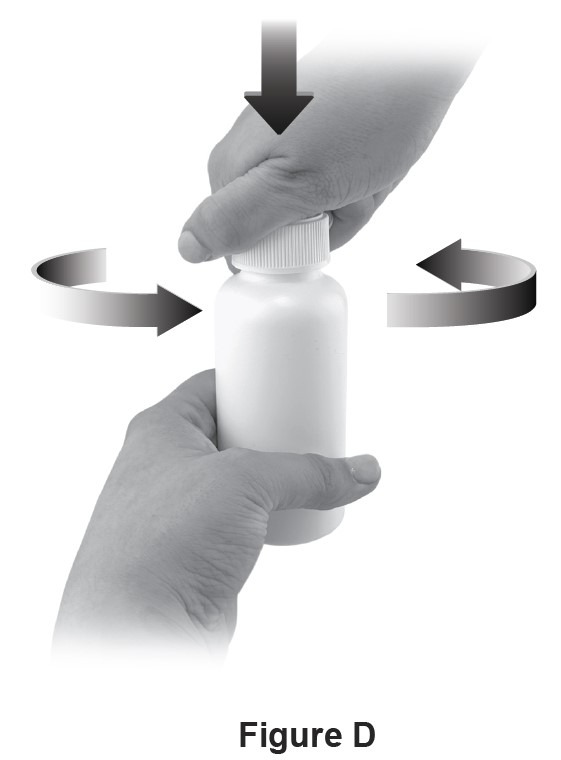
Step 3: Completely remove the inner seal from the bottle and throw it away in the household trash. If needed, the tip of the syringe may be used to puncture the inner seal (see Figure E).
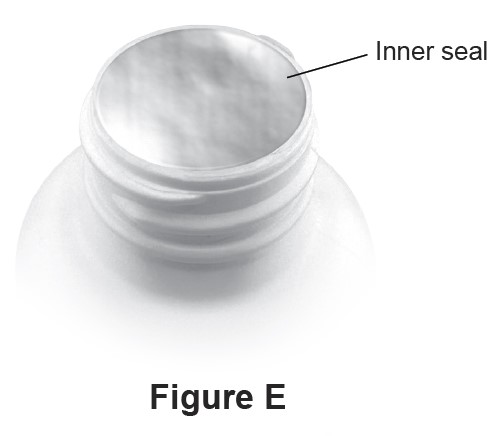
Inserting the bottle adapter into the VIGAFYDE bottle:
Step 4: Insert the bottle adapter. While holding the bottle firmly on a flat surface, push the ribbed end of the bottle adapter all the way into the neck of the bottle. Make sure that the bottle adapter is fully inserted (see Figure F). Do not remove the bottle adapter from the bottle after it is inserted.
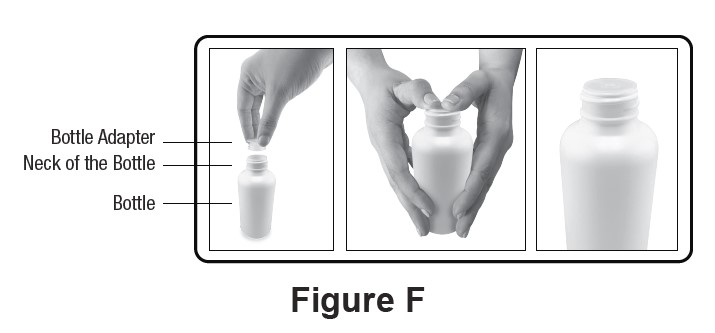
Step 5: Put the child-resistant cap back on the bottle by turning it clockwise (to the right). Record the date of opening on the bottle’s label. VIGAFYDE may be used for up to 90 days after first opening (see Figure G).
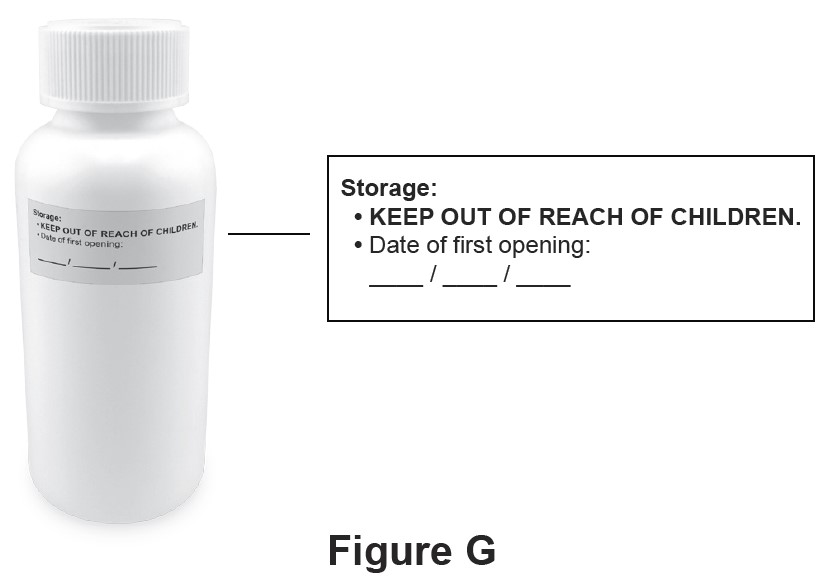
How to prepare a dose of VIGAFYDE oral solution:
Step 6: Open the bottle of VIGAFYDE by pressing down on the cap and turning it counterclockwise (to the left) (See Figure D).
Step 7: Use the oral syringe provided by the pharmacy to draw up the total number of mLs of medicine that your baby’s healthcare provider tells you to give.
Push the plunger of the oral syringe all the way up towards the tip of the oral syringe to remove air in the oral syringe (see Figure H).
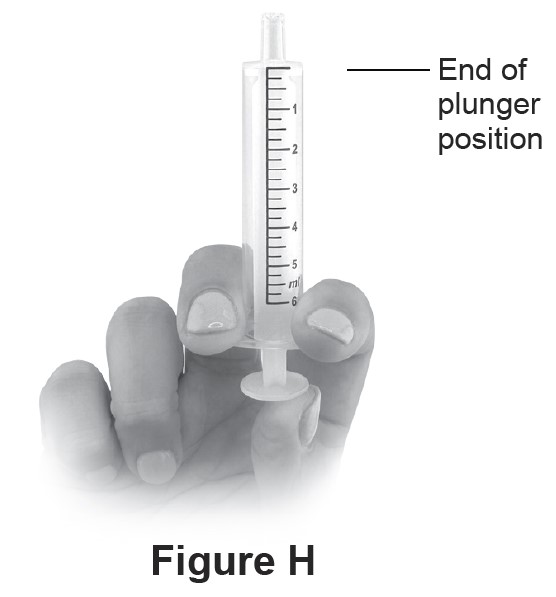
Step 8: Place the VIGAFYDE bottle on a flat surface. While keeping the bottle in an upright position, insert the tip of the oral syringe into the opening of the bottle adapter and push down gently (see Figure I).
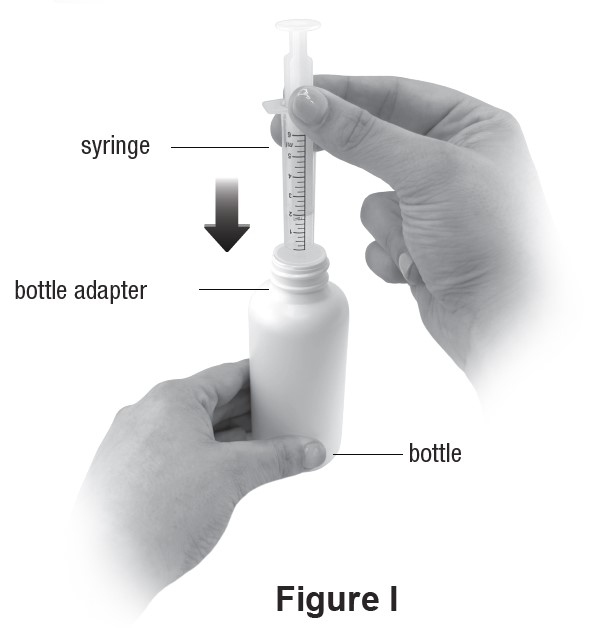
Step 9: While holding the oral syringe firmly into the bottle, turn the bottle upside down. Slowly pull back the plunger of the oral syringe until the top of the plunger stopper lines up with the mL marking (dose markings) on the barrel of the oral syringe that matches the number of mLs of medicine your baby’s healthcare provider told you to give (see Figure J).
After the prescribed dose is withdrawn, hold the plunger in place to keep the plunger from moving.
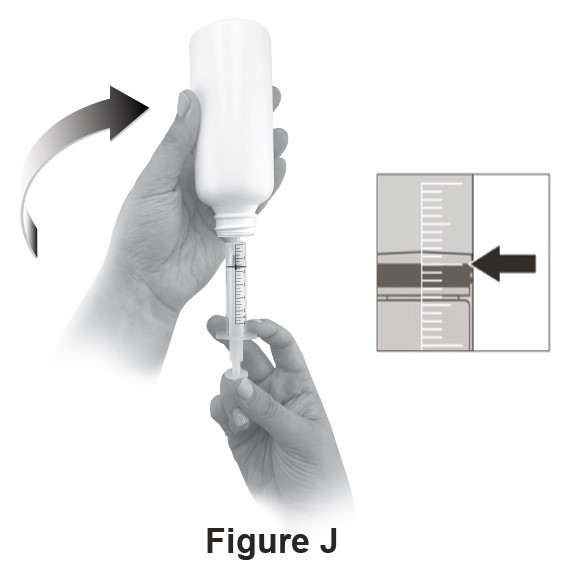
How to remove large air bubbles and measure to the prescribed dose:
Step 10: With the oral syringe attached to the bottle, check for air bubbles. Tiny air bubbles are normal. If large air bubbles are present (see Figure K), slowly push up on the plunger until the bubbles are removed. Then slowly pull back on the plunger to measure the prescribed dose. The top of the plunger stopper must line up with the mL markings (dose markings) on the oral syringe for the prescribed dose.
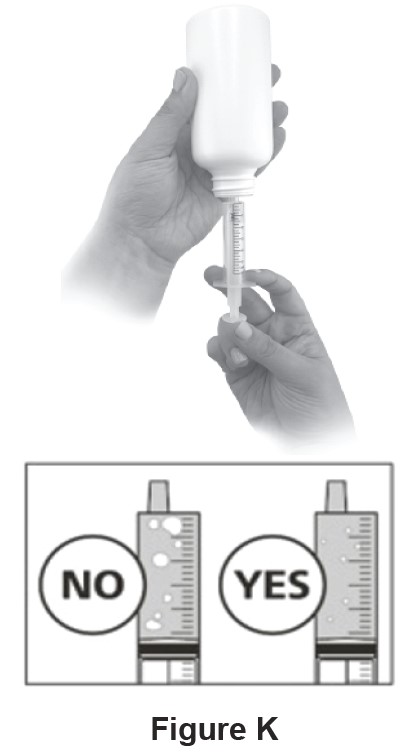
Step 11: Continue to hold the plunger in place to keep the plunger from moving. Leave the oral syringe in the bottle adapter and turn the bottle to an upright position. Place the bottle onto a flat surface. Carefully remove the oral syringe from the bottle adapter by gently pulling straight up on the oral syringe while holding the plunger in place (See Figure L).
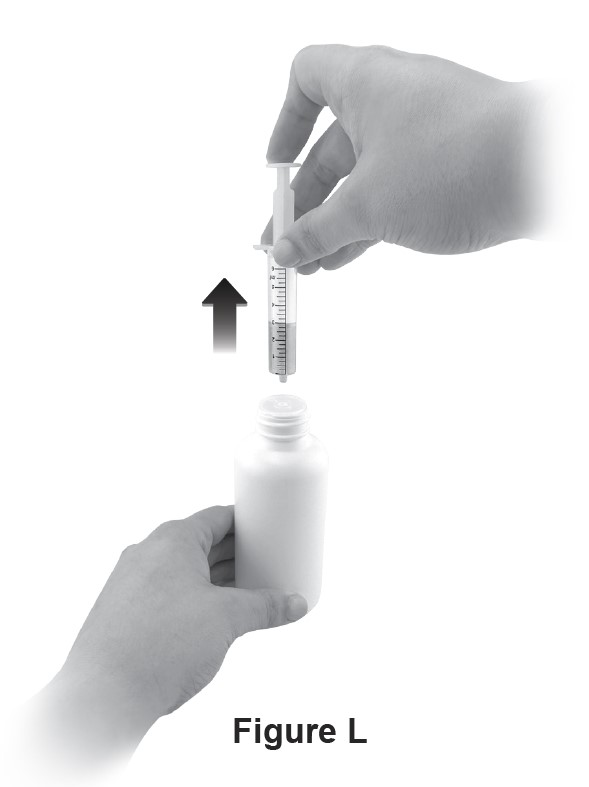
Check to make sure that the dose in the oral syringe is the prescribed dose. If the dose of VIGAFYDE is not the right dose, insert the oral syringe tip firmly into the bottle adapter while the bottle is in an upright position. Push the plunger all the way down so that VIGAFYDE flows back into the bottle and repeat Steps 9 through 11.
How to give a dose of VIGAFYDE oral solution:
Step 12:
- Giving the dose by mouth: Sit your baby upright when giving a dose of VIGAFYDE. Place the tip of the oral syringe into your baby’s mouth and point the oral syringe towards either cheek (see Figure M). Push on the plunger slowly, a small amount at a time, until all the medicine in the oral syringe is given.
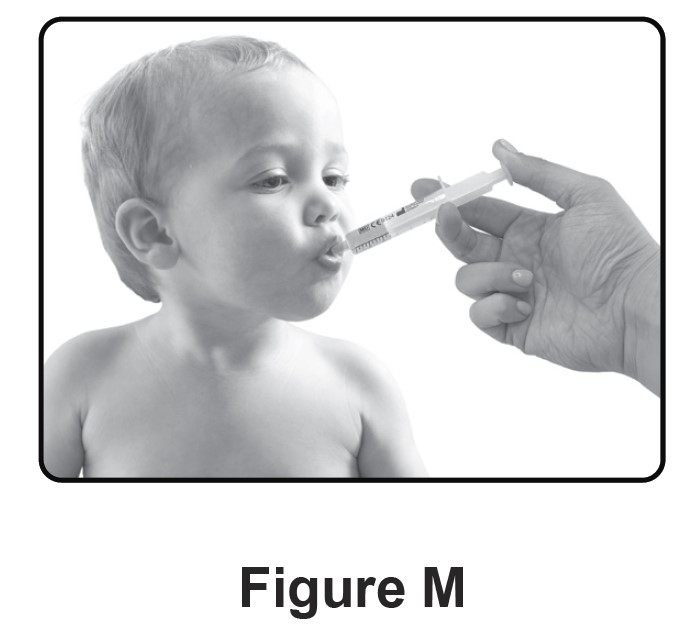
- Giving the dose by gastrostomy (G) tube: If VIGAFYDE is given through a gastrojejunal (GJ) tube, the G-port must be used. Give the medicine as directed by your baby's healthcare provider. Then flush the tube after giving the medicine with the amount of water recommended by your baby's healthcare provider.
If the dose you are giving your baby is more medicine than will fit into the syringe provided by the pharmacy, repeat steps 8 to 12 until you give the total dose of medicine prescribed by your healthcare provider.
Step 13: Leave the bottle adapter in place. Put the child-resistant cap back on the bottle by turning it clockwise (to the right). See Figure N.
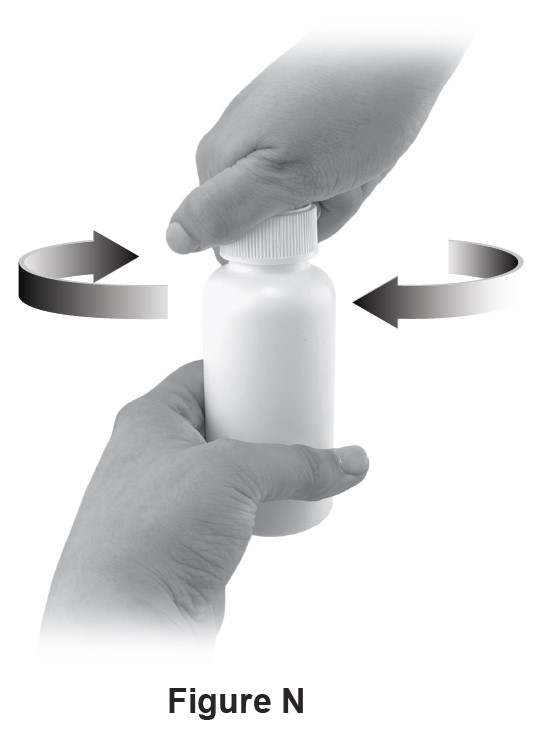
How to clean the oral syringe after use:
Step 14: Rinse the oral syringe with warm water. To clean the oral syringe, remove the plunger by gently pulling it straight out of the barrel of the oral syringe. The barrel and plunger can be rinsed with water, and allowed to air dry. After the oral syringe barrel and plunger are dry, put the plunger back into the oral syringe barrel and store the oral syringe with your medicine.
How should I store VIGAFYDE?
- Store unopened bottles at room temperature between 68°F to 77°F (20°C to 25°C). After opening, store bottle in a refrigerator or at room temperature between 36°F to 86°F (2°C to 30°C).
- Throw away (discard) any opened bottle of VIGAFYDE 90 days after first opening, even if there is still medicine in the bottle.
- Keep VIGAFYDE and all medicines out of the reach of children.
Made in the United Kingdom
Distributed by
UPSHER-SMITH LABORATORIES, LLC
Maple Grove, MN 55369
VIGAFYDE is a registered trademark of Pyros Pharmaceuticals, Inc.
This Instructions for Use has been approved by the U.S. Food and Drug Administration.
PLFT0376-3-370
Revised: 9/2025
| VIGAFYDE
vigabatrin solution |
||||||||||||||||||||
|
||||||||||||||||||||
|
||||||||||||||||||||
|
||||||||||||||||||||
|
||||||||||||||||||||
|
||||||||||||||||||||
| Labeler - Upsher-Smith Laboratories, LLC (047251004) |
Frequently asked questions
More about Vigafyde (vigabatrin)
- Check interactions
- Compare alternatives
- Pricing & coupons
- Drug images
- Side effects
- Dosage information
- During pregnancy
- FDA approval history
- Drug class: gamma-aminobutyric acid analogs
- Breastfeeding
- En español

